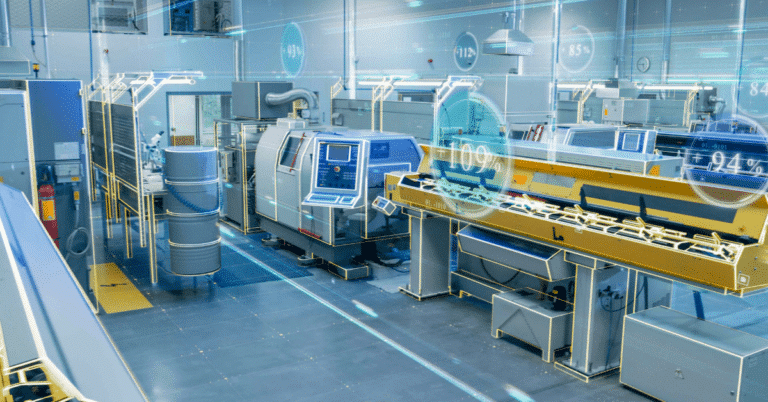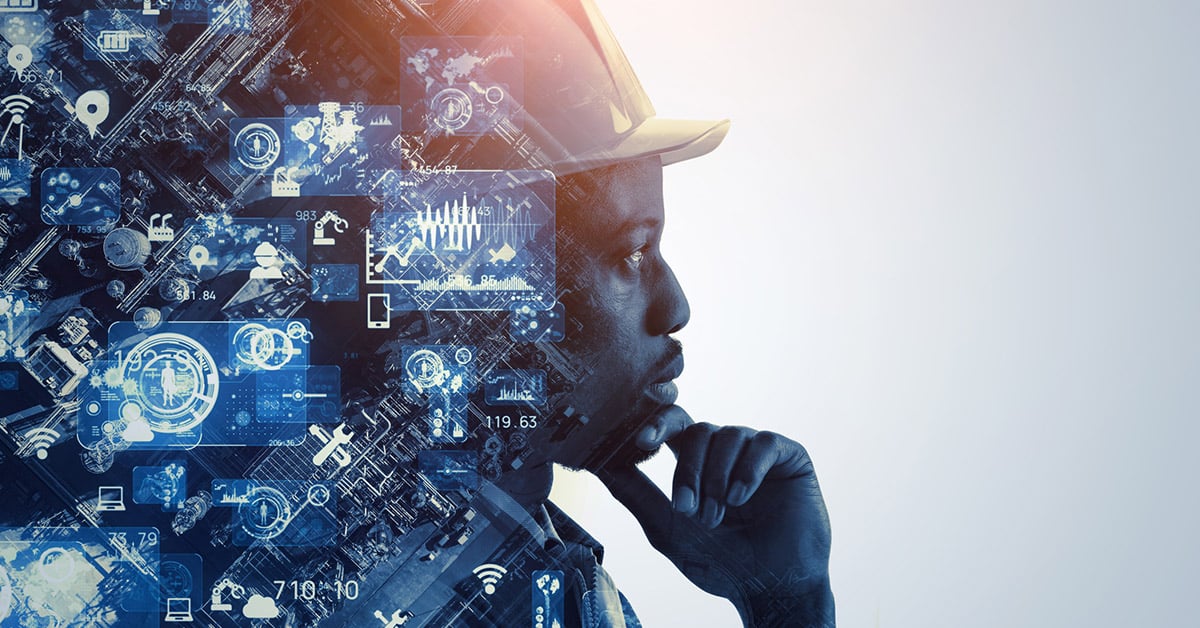Manufacturing technology and capabilities are evolving more quickly than ever, and nowhere is that more apparent than in the increasing discussion of Industry 5.0. Building on the promising advances of Industry 4.0 — data, analytics, and connectivity — Industry 5.0 incorporates cutting-edge technology while refocusing on the people who make the facility run effectively, no matter how technologically advanced.
What is industry 5.0?
Industry 5.0 technology builds on the data collection and interconnectivity delivered in Industry 4.0 — drawing on the latest technology including artificial intelligence (AI), machine learning, robots, smart machines, big data and analytics — and the continually-growing Internet of Things (IoT) – all in service of three primary tenets:
- Supporting and optimizing the work that people do
- Promoting resiliency in operations
- Driving sustainability
The history of industrial evolution is, in many ways, the history of a growing divide between people and production, with the gap filled by technology and automation. With Industry 5.0, technology and automation are being enlisted to put the focus back on people — the most valuable asset in an organization — to help them maximize their own value and effectiveness while advancing the goals of the facility.
The industrial revolution evolution: Industry 1.0 to 5.0
Since the first Industrial Revolution in the 18th century, manufacturing and industrial technology has continuously evolved — at an ever-quickening pace. Here, we will examine the history of industrial revolution and evolution from the 1700s through to today.
- Industry 1.0: Starting in the late 1700s, Industry 1.0 represents the initial Industrial Revolution — the first meaningful use of technology and machinery to drive efficiency in production. Industry 1.0 incorporated steam- and water-powered machines to replace human labor and achieve production results that would either be impossible otherwise, or prohibitively time- and labor-intensive. Several principles of the first Industrial Revolution remain in use today, and all subsequent evolution stems from the innovation and promise exhibited here.
- Industry 2.0: With the advent of electricity in the late 1800s, manufacturing technology took its next major step forward. Electrification, along with the development of the assembly line, delivered unprecedented gains in speed and efficiency from the 1870s onward.
- Industry 3.0: Continuing the trend of major advances every 100 years or so, Industry 3.0 arrived as computers and electronics became more accessible and (relatively) smaller, introducing the ability to control operations and complex processes with greater precision, more efficiency, and lower costs. Industry 3.0 introduced the automation that many people associate with the modern manufacturing facility to this day. As electronics and computers became even more widespread and cost-effective, the globalization trend — sometimes called Industry 3.5 — began to take hold around this time as well.
- Industry 4.0: This is the trend that manufacturers have spent the past decade — since the mid-2010s — learning about, preparing for and adopting. Industry 4.0 relies on industrial sensors and connected technology to deliver massive amounts of equipment performance data to be analyzed, interpreted and acted upon. The insights provided by Industry 4.0 technology and the Internet of Things — the fully connected, constantly communicating facility — have driven significant advances in automation, maintenance effectiveness, production efficiency, supply chain optimization and more.
- Industry 5.0: Industrial Revolution 5.0 continues the trend of more rapid advancement, started by Industry 4.0. Whereas early evolutions occurred roughly every 100 years, the gap between Industry 3.0 and 4.0 shrunk to roughly 40 – 50 years, while 4.0 is evolving to 5.0 even more quickly, within a span of 10 – 15 years. Rather than a major leap, however, Industry 5.0 relies heavily upon Industry 4.0 and in some ways can be thought of as a “correction” to those trends: While Industry 4.0 focused on the promise of data, analytics and automation, Industry 5.0 manufacturing will bring the focus back to people, drawing on technology to support the high-value tasks that human workers can carry out most efficiently and effectively.
Industry 5.0 practices & strategies
Primary philosophies, practices and aspects of Industry 5.0 include:
- A human-centric approach: Skilled workers have a wealth of knowledge, talent and intuition that simply cannot be replicated by machines, no matter how advanced – and these qualities are in high demand now more than ever. Industry 5.0 draws on technology to support these skills, and in order to remain viable and competitive, facilities must show current and potential employees that they are willing to help support and develop them. Facilities have found that employees — much more so than machines or technology — are truly their lifeblood and that worker shortages can slow down operations or bring them to a standstill. The next generation of skilled workers will expect to be supported by technology, but not to take a back seat to it.
- Supporting humans, not superseding them: AI, robots and automation are here to stay and will continue to evolve — but Industry 5.0 is built on the idea that technology is only as good as the people who enable, inform and use it. Industry 5.0 intends to create harmony and balance between the efficiency, speed and productivity of machinery, along with the expertise, experience and institutional knowledge of human workers. If Industry 4.0 instilled any fear that automation might replace the need for human workers, Industry 5.0 is a major correction to that thought.
- Resiliency: Look at any example of technology or automation — its effectiveness is directly correlated to the quality of the input that it receives, whether programming, data or otherwise. Automation and technology like artificial intelligence are extremely effective at predictable, repeatable scenarios and tasks, but will quickly fall apart in the face of unexpected challenges. Events like the global COVID-19 pandemic illustrate the need for resiliency in the face of crisis and uncertainty — something that machinery can’t handle, especially in unprecedented times. Industry 5.0 aims to leverage technology to help people do what they do best — innovate, think on their feet and use all the tools at their disposal to weather and ultimately overcome the challenges that they face.
- Sustainability/ESG: Green manufacturing is no longer a buzzword or a “nice-to-have.” It is a competitive edge and a critical consideration in keeping the facility cost-effective, agile and productive. Moreover, environmental benchmarks must often be met in order to win government contracts and other business. Industry 5.0 maintains a direct goal of using technology to meet sustainability and ESG (environmental, social and governance) goals.

Industry 5.0 technologies
Robots and cobots: Robotics in Industry 5.0 play a key role in the evolution of technology. While automation has been commonplace since the 1960s and 1970s (Industry 3.0), it has typically been a process that operates separately from people — primarily for safety reasons. With Industry 5.0, people will work directly alongside collaborative robots — cobots — fulfilling high-value, complex tasks with ease by drawing on the advantages of human ingenuity and robot speed and strength.
AI & machine learning: AI and ML are often discussed in the context of Industry 4.0, but the major advances in these technologies mean that they will play an even more significant role in Industry 5.0. AI and ML will be able to troubleshoot, suggest remedies, QC and help maintenance technicians complete diagnostic and repair tasks more quickly than ever before.
Predictive maintenance: Predictive maintenance has been a primary beneficiary of Industry 4.0 technology and will only continue to expand with Industry 5.0. As both an art and a science, predictive maintenance is perfectly suited for the refocus on human technicians and the intuitive, instinctual understanding they have of equipment and operations.
Smart machines: Built on IoT connectivity, smart machines will draw on data, edge computing technology and communication to provide insight and autonomy more than ever to maintenance technicians and equipment operators alike.
Augmented & virtual reality: AR and VR in manufacturing have risen in stature during Industry 4.0 and are poised to become key parts of maintenance and production operations with Industry 5.0. Facilitated by wearables such as goggles or glasses, AR and VR facilitate informational overlays on “heads-up” displays to support maintenance operations, while also enabling close collaboration between workers who may be thousands of miles apart, making it seem as though they are working right alongside one another.
Are we experiencing industry 5.0 right now?
In short, yes — Industry 5.0 involves many Industry 4.0 technologies that you’re likely already familiar with. More than a technological shift, Industry 5.0 represents a mindset shift, rethinking technology to support a new set of values and practices centered around human workers. This technology is rapidly accelerating, but with an Industry 5.0 mindset, it will always operate in service of people.
With this understanding of Industry 5.0, you may confidently prepare for the next major step in the evolution of manufacturing technology and, more important, for the impending paradigm shift in the focus on people. This knowledge will help you keep a competitive edge, retaining your all-important personnel while understanding how to leverage technology to support them. Contact ATS to help you on your journey of technology-driven industrial maintenance.


